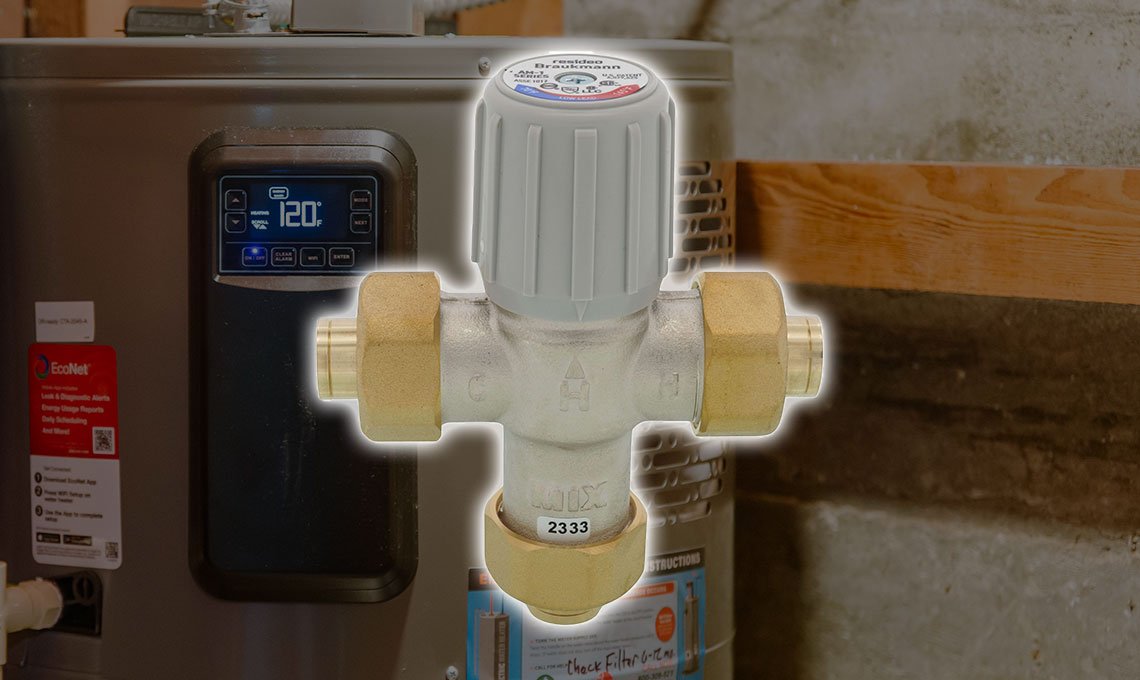If you’re thinking you need more hot water, perhaps because your household is growing or you’re home more often, a mixing valve can improve the performance of smaller tanks and help you avoid having to upgrade to a larger unit. However, it’s important to understand how mixing valves work, how they can affect your energy use and what the potential drawbacks are.
What is a mixing valve?
A mixing valve is a mechanical device attached downstream from your water heater’s outlet. It adds cold water to the hot water leaving your water heater, effectively increasing the amount of warm water being delivered to your home. To ensure that the water arriving at the point of use is sufficiently hot with a mixing valve, the water heater setpoint can be turned up to 140°F. This is easily done on a heat pump water heater using the control panel.
When you’re increasing the temperature setpoint of your water heater and adding a mixing valve, a good rule of thumb is that every 10 degrees increase the temperature is like increasing the volume of your heater by 10 gallons. For example, adding a mixing valve to a 50 gallon tank and turning the temperature setpoint from 120 degrees to 130 degrees would make it perform like a 60 gallon tank. The cold water introduced by the mixing valve will also temper the very hot water coming from the water heater, so the water arriving at your sink or bath will feel just like you’re used to.
How does a mixing valve affect energy efficiency?
Storing hotter water and using a mixing valve will lead to slightly higher standby heat loss than normal. However, if you have a heat pump water heater, you will still see significant energy savings over a conventional electric tank.

What are some of the drawbacks?
While installing a mixing valve is relatively easy and fairly inexpensive, it’s important to keep in mind that these devices require maintenance, such as cleaning, to keep them working properly. The normal lifespan for a mixing valve is around 5 to 6 years, and they typically fail gradually over time, allowing more hot water through them. In the Pacific Northwest, mixing valves are less likely to fail because of the high-quality water and low calcification. Still, a failed mixing valve can be dangerous if you are exposed to hotter-than-safe water temperatures. Periodically test the water temperature at your sink and watch for any changes.
If you have a mixing valve and turn your water heater up to high temperatures, such as 140°F, be aware that such hot water can shorten the life of your water heater due to increased corrosion, a more frequent need to change the anode rod and calcification. It may also void your warranty.
It’s also worth considering that water stored at high temperatures will kill dangerous bacteria quicker. Most notably Legionella, which leads to Legionnaire’s disease and grows best in water temperatures of 77–113 degrees. Water stored at 120 will kill the bacteria in a matter of hours; 140 degree water will kill the bacteria in a fraction of that time.
Overall, adding a mixing valve to your water heater can be an easy way to effectively increase your water heater’s capacity. However, it’s important to weigh the benefits and considerations carefully and ensure that you take the proper precautions to maintain a safe and efficient system.
Start your savings journey today.
See how much you can save upfront on a heat pump water heater.
Connect with a qualified local professional for quotes and service.
Discover nearby retailers and explore our DIY Guide for help upgrading to a heat pump water heater on your own.
